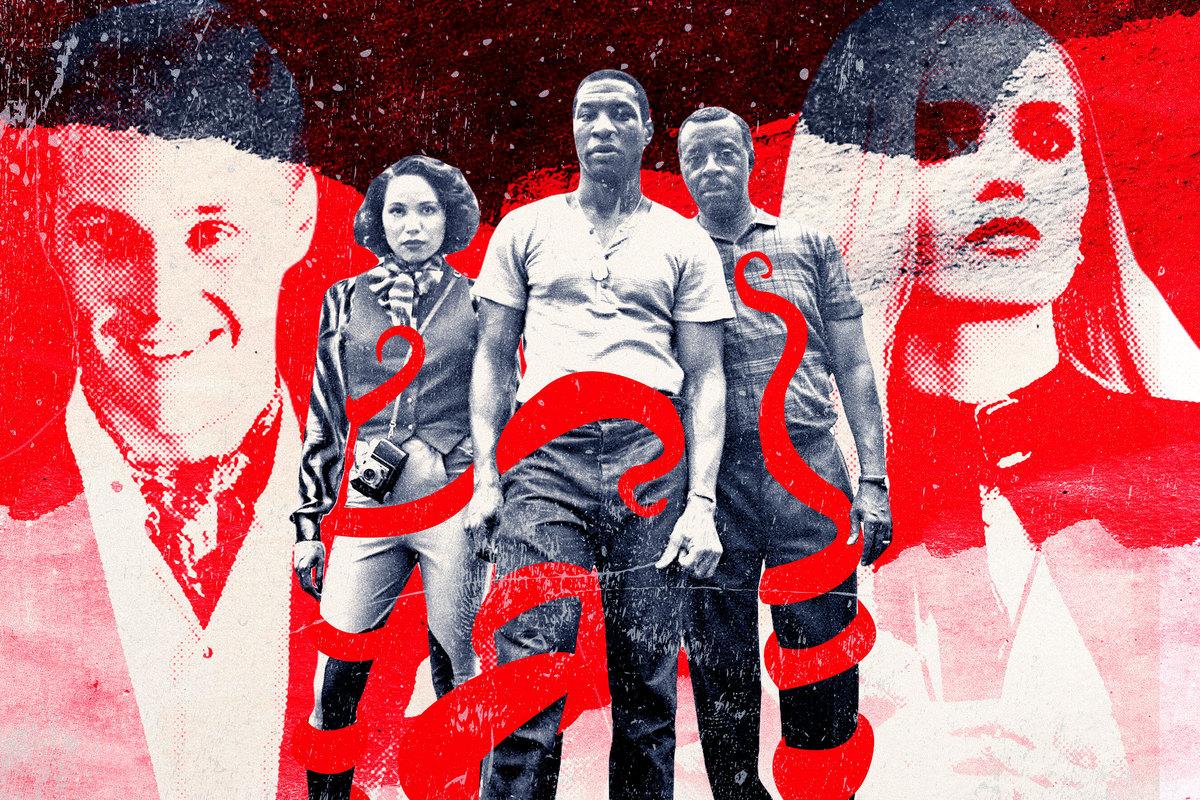
If “Whitey’s on the Moon,” the second episode of HBO’s Lovecraft Country, has an emotional high point, it comes when George last speaks to Tic and Leti. That may seem counterintuitive in light of the fact that George did, after all, die at the end of the episode, expiring in the arms of his brother (played by Michael K. Williams, who uses every ounce of his skill to emit the kind of grief that only an emotionally calcified man like Montrose could). George had been this group’s patriarch, and his death—should it stick, because in this show, it might not—will surely send them down a maze of increasingly perilous paths. And yet, George’s demise was nowhere near as gut-wrenching as Tic and Leti’s final conversation with him.
That talk happened in a hallway, after each had encountered hauntingly personal visions in their rooms that preyed on their deepest desires, guilts, and fears. Tic fought a woman in army fatigues before choking her to death (she appeared to be the same person he called in Korea in the season premiere); Leti, after sharing a deeply traumatic memory of her mother and kissing a vision of Tic, was attacked when fake Tic’s … uh … parts … turned out to actually be a giant snake. Both instances were unnervingly intimate and, most importantly, fake: A fraternity of mirage-wielding white wizards known as the Order of the Ancient Dawn was watching their every move through the walls. Christina Braithwhite—the daughter of the highest-ranking member of the Order—engineered the group’s arrival in Ardham, kidnapping Montrose in hopes of luring Tic to their confines and winning the approval of her own father, Samuel (a man who feeds his own liver to his guests later in the episode). George was the only one who saw their game for what it was and stopped playing. A vision of Tic’s mother, who the show seems to be suggesting was more than just a sister-in-law to George, appeared to him. They danced together for a moment before he kissed her on the forehead and said regretfully, “You’re not real.”
Upon reuniting in that hallway, Tic and Leti understood that they had just been toyed with by a bunch of sadists who somehow knew their most personal thoughts. George kept them from falling apart. “Don’t you ever let them make you question yourself,” he said, his voice full of power. It was, given the context of the episode, an utterly heroic moment.
“Whitey’s on the Moon” is set entirely between Ardham—the Massachusetts town that the group was searching for before they were attacked by those vampire-things in the season premiere—and the mansion of its wealthiest inhabitants, the Braithwhites. The Braithwhites are an altogether disturbingly Aryan family with a patriarch who’s convinced he’s discovered the path to eternal life. The episode provides a look into the mechanics of the Braithwhite-led group, the Order of the Ancient Dawn, and the surrounding village that it operates out of. It is not entirely clear whether everyone in Ardham is directly associated with the Order or simply willing bystanders to their activities. For Tic, Leti, and George, their time in Ardham serves as an opportunity to redouble their search efforts for Montrose, as it quickly becomes clear that he didn’t end up there of his own accord. They are steadfast in their commitment to find him and leave their new confines, but their attempts are blocked at every turn by the Braithwhites and their acolytes.
When the group wakes up in the Braithwhite mansion after the horrors of the end of Lovecraft Country’s premiere episode, only Tic remembers what happened. In the early stages of “Whitey’s on the Moon” his memory is constantly questioned. George and, more frequently, Leti both wonder how they could have been attacked by vampiric monsters without remembering any of it; Leti suggests that Tic may be experiencing PTSD from his time in the Korean War. The Braithwhites’ butler-who’s-not-a-butler (he refers to himself as “a personal friend to Ms. Braithwhite’’) has somehow repaired the group’s car, which suffered extensive damages in the previous evening’s events. He tells them that he simply found it in this condition, parked in the woods.
Throughout the episode, Tic points out the inconsistencies in their setup: How can the Braithwhites have rooms stocked with clothes that fit Leti perfectly or bookshelves lined with all of George’s favorites novels? And why do neither of them remember anything at all about the previous night? After exploring the conspicuously racist and vaguely pagan village of Ardham—at one point a bunch of kids are literally wrapping a wicker man in red rope—the group is attacked by the vampires again, and George and Leti are the ones left questioning themselves. Moments after the ambush they cannot even recall how they ended up covered in dirt.
This theme of memory and reality is where “Whitey’s on the Moon” soars. The group is confronted, in stunning frequency, by individuals committed to disrupting their perceptions of past and present. When Leti is (temporarily) killed after the group finds Montrose and attempts to escape, it is clear that these characters are merely pawns in the Order’s power games. What Tic, Leti, George, and Montrose are experiencing is, essentially, gaslighting. Their perceptions are uniquely vulnerable to the manipulative whims of their dominators.
When I was watching “Whitey’s on the Moon” I kept thinking about a scene from Avengers: Infinity War. Lovecraft Country and Marvel’s most famous franchise have virtually nothing in common at face value, but there is one bit of dialogue in particular that I couldn’t get out of my mind after seeing this week’s episode. In Infinity War, when Tony Stark and Dr. Strange first meet each other, they get into an argument over their respective bona fides. Dr. Strange ends their conversation by sarcastically reminding Stark that the reason he’s never heard of him is because he’s been busy “protecting your reality, douchebag.”
The theme that “Whitey’s on the Moon” keeps trending toward is basically: What does it feel like to have your reality eternally in question? What does it look like when your experiences are abrogated by a group of people who are so powerful that they can undermine the very premise of observable truth? What do Black folks—or members of the LGBTQ community, or women—go through when navigating institutions bent on undermining them? What Lovecraft Country is exploring is a real-life, intersectional dilemma. The term “microaggression” is overwrought—it has lost the power that it once had—but it was created for moments like these: when your experiences are not just questioned, but subsumed and repurposed by a dominator. For Tic, Leti, and now Montrose, their realities are always under fire, whether that’s by the Braithwhites, America, or even each other. That’s why George’s warning was so profound. He reminded them that what they were going through was nothing new and that to survive, they will have to endure.
History Lesson: Slavery in the North
So far, Lovecraft Country has excelled most when it subverts established historical tropes. The backstory that undergirds “Whitey’s on the Moon” is another perfect example of this. While Tic, Leti, and George are touring the Braithwhites’ home, they learn that the property was built on the grounds of Titus Braithwhite’s former lodge. Titus, whose claim to fame in the wizard-adjacent world was his unrivaled understanding of the Book of Names, was killed in a fire in 1833 along with nearly all of his followers. The butler-who’s-not-a-butler mentions that before his death, Titus “was known to be notoriously kind to those who worked for him” and made his money from “shipping” (to which Leti astutely responds “that’s code for slaves”). Later in the episode, George remembers a story that Tic’s mother told him about her ancestors, one of whom escaped bondage while pregnant (with her master’s child) and killed her master in a fire. The contention is that Tic’s mother was descended from the same enslaved woman who burned the original Braithwhite estate and killed Titus Braithwhite. The ceremony that Samuel attempts on Tic toward the end of the episode—which, of course, ultimately backfires and turns Samuel into stone—is directly connected to this legacy.
Lovecraft Country is one of the few popular media depictions that locates slavery in a place like Massachusetts. It is not an accident that contemporary portraits of American bondage center The Peculiar Institution in the agrarian South. It is an easy narrative: Together, the collection of states that would later form the Confederacy did have the largest number of enslaved bodies in the U.S. (although, the single largest individual slave-owning state was actually none other than the northernmost member of the Confederacy: Virginia). But that did not absolve the North from its entanglement with bondage. Beyond the fact that Northern textile mills and shipping ports directly profited from the excesses of enslaved labor, Northern cities and towns themselves have an extensive and direct history with enslavement. When European settlers first arrived in North America, they enslaved the Indigenous people of this country. This practice continued well into the 18th century. And once the importation of African captives—a process that was itself motivated by Native American resistance to bondage—began in full, Northern settlers engaged in chattel slavery at an abundant rate. By 1730, 42 percent of New York City’s white population were slave owners, “a higher percentage than in any other city in the country except Charleston, South Carolina.” In 1765, enslaved people made up 2.5 percent of the entire population of Massachusetts. Rhode Island, which had the highest percentage of enslaved people in New England, didn’t officially ban the institution until 1843, less than two decades before the Civil War.
While slavery in the South entailed mostly wide-scale plantation labor (in addition to some mining and industrial work), Northern enslavement was far more isolating. Individual farms in the North frequently had a small number of captives, whom they would rely on for a wide range of duties. In cities, enslaved people worked at seaports, as stonemasons, and in individual homes. Northern enslaved populations typically lived in the same homes as the families who forced them into bondage. Across eras this narrative has been downplayed and in many cases outright ignored, reinforcing a false history of American white supremacy as a binary between North and South. In choosing to locate the Braithwhite family legacy in Ardham, Lovecraft Country is once again challenging the ways in which we view the legacy of racism in our country.
Throwback: Gil Scott-Heron’s “Whitey on the Moon”
In a follow-up to the James Baldwin monologue that was featured in the season premiere, showrunner Misha Green layered another piece of revolutionary pop culture into this week’s outing: Gil Scott-Heron’s “Whitey on the Moon.” Released in 1970 as part of his seminal debut album Small Talk at 125th and Lenox, “Whitey on the Moon” is a biting exhibition of social commentary. Throughout the poem, Heron juxtaposes America’s capacity to literally transport white astronauts to the moon while remaining indifferent to the suffering of Black communities back on earth. The song, which the episode is also titled after, plays in the background during the ritual scene when Samuel attempts to exploit Tic’s blood ties to Titus Braithwhite and open a portal to the Garden of Eden. (These white dudes are very into Genesis.) As beams of energy pour from Tic’s chest, Heron riffs:
I can’t pay no doctor bills, but whitey’s on the Moon
Ten years from now I’ll be payin’ still, while whitey’s on the Moon
The man just upped my rent last night, ’cause whitey’s on the Moon
No hot water, no toilets, no lights, but whitey’s on the Moon
Heron uses his “sister Nell” and her descent into poor health to demonstrate the brutality of American social spending. Just as a flare of mystic power spills out of Tic and turns the entire Order of the Ancient Dawn into stone, Heron croons “I think I’ll send these doctor bills, airmail-special, to whitey on the moon.” In the context of Lovecraft Country, “Whitey on the Moon” serves as a reminder of the ways in which the unconscionable resources of the powerful (in the show’s case, white men even have a monopoly on magic) are inseparable from the conditions of the oppressed. Even in the show, power begets suffering.
One Lingering Question
The most surprising takeaway from “Whitey’s on the Moon” has to be the fact that George appears to be gone. (How the heck did they get Courtney B. Vance to agree to appear in just two episodes?!) One of the most frustrating aspects of the show’s initial entries has been the lack of characterization—the characters on screen have at times read less like living, breathing people and more like personified thinkpieces. There has been little attempt to define them because they are vessels for a larger historical argument.
George was one of the few characters who generally avoided this trap. We knew what his values were and what he desired. It was increasingly clear that he had skeletons in his closet, and yet it was equally evident that he was actively trying to grapple with them. He was the only accessible link between the present narrative and a past that has gone largely unexplained on the show. The question, moving forward, is: Now that he’s gone, how will Lovecraft Country fill the void he’s left behind?


